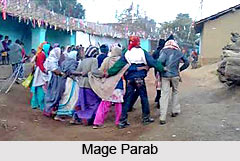 Mage Parab is celebrated at the end of Porus i.e. during the month of December-January and in the beginning of Magh i.e. during January-February. The central idea behind the celebration of the festival is to offer new pulse and other cereals to the ancestors. No fixed dates are appointed for the celebration of the festival as different villages observe the festival on different dates. During this period the three days fast, Monday, Wednesday and Friday are taken into account.
Mage Parab is celebrated at the end of Porus i.e. during the month of December-January and in the beginning of Magh i.e. during January-February. The central idea behind the celebration of the festival is to offer new pulse and other cereals to the ancestors. No fixed dates are appointed for the celebration of the festival as different villages observe the festival on different dates. During this period the three days fast, Monday, Wednesday and Friday are taken into account.
The wife of the Pahan is relegated an important role in the festival. She is entrusted with the job of preparing the sacrificial beer, made almost three or four days before the festival after bathing and observing a fast. The tribal group next perform the Haua. Three days prior to the festival a big drum is beaten before the house of the Pahan during dusk. At the sound of the drum the youths and the maidens of the village assemble at a particular place and engage in dancing and singing while going round the village. They move from the eastern side to the northern side and moving anti-colockwise they re-enter the village from the eastern side. The arrangements for the sacrifice to be performed during the festival are done by the Pahan prior to the celebrations. Three days before the festival, the Pahan decides upon a site in the vicinity of his house, smears it with cow dung and plants or branches of Sal tree fetched from the jungle by the village youths. The Pahan on the selected site prepares three leaf cups and plates. He then addresses the villages and bows down before the three cups offers ritual rice beer to the ancestor. The residual rice beer is then consumed by the Pahan, his family members and the young people who brought the sal branches from the jungle.
On the preceding day of the festival the bongas and tutelany spirits are invited. The Pahan`s wife early in the morning cleans the whole house and smears the courtyard with cow dung. During evening hours the youths of the village march towards the Pahan`s house shouting and addressing the spirits to partake in the sacrifice. Burubonga, Ikirbonga, Binsliera, Nageera, Chandi, Charonra, Desanti are some of the spirits usually invited. The spirits of other villages that reside in the vicinity of the village boundary are also invited for the ceremony. The spirits are sometimes identified with an animal, a bird and others. The rituals are followed by dancing throughout night and concluding with cockrow where all the dancers are offered a cup of rice beer.
On the day of the festival the village youths accompany the Pahan to a nearby pond or stream. After taking bath the Pahan on his way back plucks a branch each of mage ba and garajono. Meanwhile his wife cleans and plasters the courtyard with cow dung. Upon returning the Pahan makes arrangements for the sacrifice. A wide mouthed hole in dug and an oven is placed beside it. His wide fetches the soaked paddy that is roasted by the Pahan and is then beaten by the assistant. Arwa rice and ramra pulse are then powdered and he takes three pancakes out of it. Before initiating the rituals the Pahan gathers the rice beaten flat, the pancakes, the sacrificial fowl, the ritual rice bear and the branch of the mage ba. A fowl is sacrificed during the ritual and its blood is poured on the three heaps of the rice placed before him. Three pieces of pancakes are then offered to the thread heaps of rice and a libation of the ritual beer is also presented. The feasting marks the end of the sacrifice. The Pahan next departs for his home followed by his assistant and the villagers singing the Haua song on their way. The Pahan then cooks rice and the sacrificed fowl in a new earthen pot and takes them where he had planted the branch of a self-grown sal tree. The meat is first offered and the rice and the rice beer before the three heaps of rice sprinkling water on them.
After the Pahan declares the sacrifice to be over, the Mundas engage in feasting and drinking. The Pahan boils some rice in an oven placed there and hands it over to his wife who then offers it to the family ancestors in the adiri. Following the feasting the Mundas set in for collecting pancakes from door to door as it is essential for every house to present at least one pancake. This ritual is marked by dancing and singing of haua songs.
















